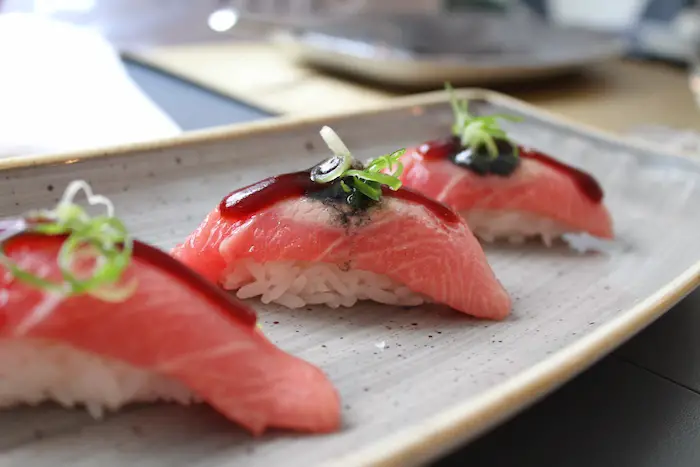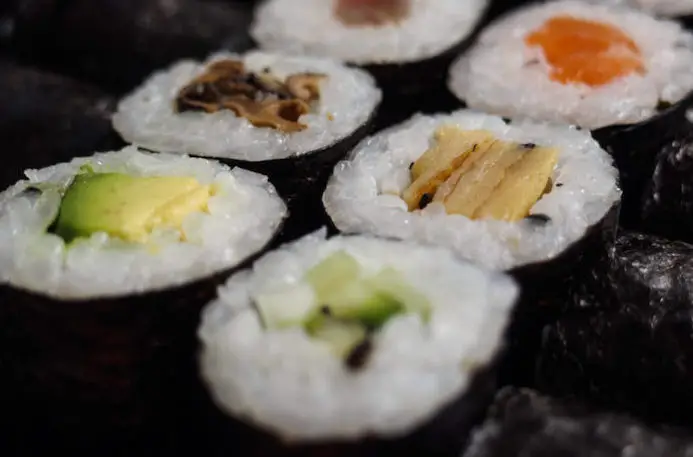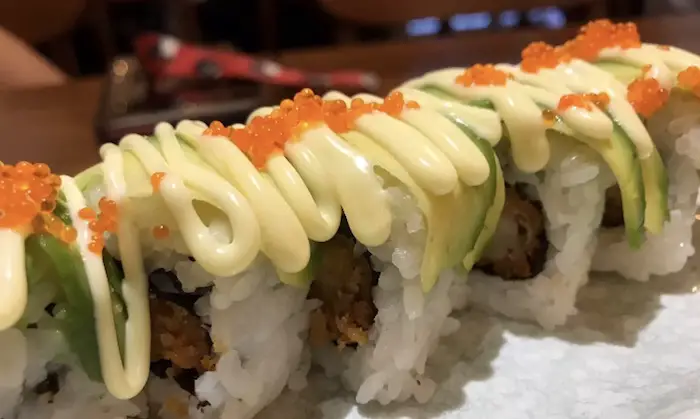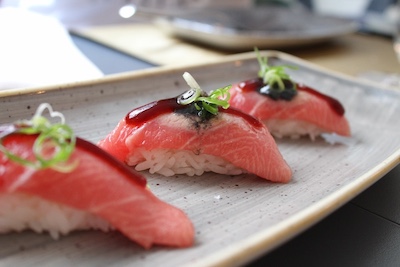We are reader supported. When you purchase through links on our site, we may earn an affiliate commission. Also, as an Amazon affiliate, we earn from qualifying purchases.

Eating out is always a bit pricey, especially when you want to go to a fancy sushi restaurant. Cheap, pre-made sushi is now sold at many stores in some counties like America, but you may want to reconsider. The raw fish in those grocery store options are not very fresh and not the best quality. No mater your past experiences with sushi, this dish is quite well known around the world, and many people eat it regularly!
So why is sushi expensive? To get quality sushi you need quality ingredients and highly skilled chefs. This all takes considerable amounts of money, and your sushi is only as good as the chef and his ingredients.
Import prices and preparation of each sushi dish take up most of the revenue for sushi restaurants That means that most places outside of Japan will be on the pricier side, and the fish wont taste as fresh. Even many sushi places in Japan face this overpricing issue, so we are here to help you find the perfectly priced sushi without sacrificing on quality!
Contents
How Much Will You Spend On Sushi?
The price of sushi is highly dependent on where in Japan, or the world, that you chose to dine. In Japan, you should expect to pay anything from 1,000 yen per person to a staggering 10,000 yen. This roughly translates to $9.38 up to $93.80 in U.S. currency.
Of course, the cheapest options would be conveyor belt sushi restaurants, but keep in mind that you get what you pay for and these can still rack up quite the price tag for big groups. The best places to try sushi or sashimi would be fish markets and other kinds of busy seaside market places. These locations may offer sushi that is average in price but not suffering in quality, with the added bonus of maybe watching the chef prepare your sushi and sashimi while taking in the sights and exciting atmosphere.
Another great thing about fish markets is your sushi and sashimi will be very fresh, as many places will have bought the fish from that morning’s catch. Sushi is also priced on a day to day basis. The cost depends heavily on the flow of customers and what they were able to buy or catch as well as the quality of that fish.
Price is Not King When Buying Sushi
The most important rule for eating sushi is to look for places that have a good sushi reputation, not by looking at the price tag. To do this, try asking around with the locals. Or if you are in Japan, try hiring a travel guide; they are quite common for foreigners and very friendly. They may translate for you and show you some of the best places in that area—even considering your price range when they make suggestions, too.
See Also: Best Sushi Restaurant That Served Barack Obama
Sushi or Sashimi?
Many people do not realize that sushi and sashimi are two completely different foods. They incorrectly use the two words interchangeably.
The big difference between sushi and sashimi is that sashimi will always include raw fish as its main ingredient. Sushi, on the other hand, will be made primarily with vinegar rice, vegetables, and eggs. However, there are some sushi recipes that include raw or cooked fish so always make sure you know exactly what it is you’re about to eat.
Along with sushi and sashimi there is fugu. Fugu is puffer fish, and it requires years of specialized training and skill to prepare. You may have already heard, but it’s worth repeating. Fugu can be toxic to humans if prepared incorrectly.
See Also: Difference Between Nigiri, Sashimi, Sushi Roll, Hand Roll, Gunkan Sushi
Can You Accidentally Eat Puffer-fish?
It’s not likely you’d accidentally eat fugu, but it’s important to be aware. Thankfully, the cases of puffer-fish related deaths in Japan are quite low, provided you go to a certified fugu chef. With a little research, you can easily find some chefs who can prepare this dish. Priced roughly around $37.33 USD it’s a good thing fugu or blowfish can only be sold and prepared by licensed chefs. This meal can be shared by a maximum of two people and is certainly worth it if you’re adventurous.
Is There Sushi with No Fish?
Yes, sushi comes in styles without fish. Most sushi will not have raw fish. There is a type of sushi that involves grilled salmon which is quite delicious, but if you are looking for a sushi with no meat involved then there are vegetable sushi rolls or you can try some Tamagoyaki.
Tamagoyaki is not technically sushi as it involves no rice. It is a pan-fried omelet but very dense and fluffy with a slightly salty fish flavor. Sometimes you can find very small slices on sushi rice which is great for people who are hesitant to try raw fish.
How Many Kinds of Sushi Are There?
There are many types of sushi, using many types of ingredients. In recent years, the popularity of sushi has grown, and there are now many westernized types of sushi. These are usually quite elaborate and use a lot of avocado.
We have nigiri, sashimi, maki, uramaki, and temaki. These make up our basic sushi categories and based on the freshness and quantity their prices may drastically change on a day to day basis.
Nigiri
Nigiri is a type of sushi that is typically topped with fish and served on a special type of sushi rice or vinegar rice. Not all nigiri is raw fish. Sometimes the chef will grill it with a blowtorch or top the rice with egg or vegetables. This type of sushi can vary from 2 to 4 USD per piece for low-end nigiri. With higher end nigiri, the price can be anything from 5 to 14 USD per piece. And these prices can change depending on if you are eating at a fish market or a restaurant.
Sashimi
Sashimi uses slices of raw meat, usually fish, as its only ingredient. Many people would turn their nose at such a dish but the cases of illness from consumption of raw fish is surprisingly low, provided your chef has prepared your food correctly.
Sashimi is raw fish, tuna being the most popular and exciting to watch being prepared. There is another type of sashimi called basashi. Basashi uses raw horse meat and fresh veggies. While certainly a strange and taboo idea in some countries, consumption of horse meat is not that strange and it is quite tasty.
If you want to be adventurous and try fresh sashimi for yourself, the prices vary from 8 to 15 USD. This also changes on supply and demand as well as where and how you chose to dine. In a restaurant, you should expect to pay around 36.79 to 55.66 USD and this is served on a fancy plate or wooden slab with a mix of veggies and sauces.
Maki

Maki is a type of sushi roll that is made up of rice, fillings, and wrapped up in seaweed sheets which are called nori. The fillings for maki rolls can vary from fish, fish eggs, eggs, and vegetables so they are quite popular with folks who are still hesitant to try the more adventurous types of sushi.
Your maki rolls should be nice and crisp with the seaweed. Never eat any sushi that smells odd or if the nori wrap is soft. Cold rice should also be avoided in any sushi. Maki rolls are typically sold by the roll, and a single roll of maki serves 8 pieces with wildly fluctuating prices based on what you want, veggie maki rolls being the cheapest options.
Getting maki at fish markets by the piece will likely be quite cheap as you can mix and match lots of sushi types in one takeout box. This is a fun experiment to test fairly average sushi that is decently priced.
Uramaki

Uramaki is basically the same as maki, but it’s completely inside out. The filling is on the inside wrapped in seaweed then the rice around that. This is a more complex sushi roll so the price will usually be quite steep starting anywhere from 27.36 to 33.02 USD. You still get the 8 pieces per roll just like with normal maki rolls, but due to the complexity of this sushi, it really isn’t that common in the markets. Uramaki is primarily sold in restaurants.
Temaki
Temaki is a fun-looking type of sushi roll. Nori is rolled up into a cone shape and then filled with sushi rice and either fish or vegetables. This particular type of sushi is not super common in markets, but you may be able to find some in small street shops.
Like all sushi, temaki changes price based on the time and day as well as location. You should expect to pay anything from 5 to 10 USD for temaki rolls.
Conclusion
These are just some of the traditional types of sushi. Many new western types of sushi are being invented each day, it seems. None of the sushi prices listed here should be taken as a set rule, as sushi is a constantly fluctuating market. The best way to get good sushi is to get in some leg work and ask around.
Wherever you chose to eat sushi, it should have highly trained chefs and a solid sushi reputation, especially if you plan on partaking in anything with raw ingredients.
See Also: Difference Between Japanese Sushi And American Sushi
Related Questions
What Is The Most Expensive Sushi?
The title for the most expensive piece of sushi is given to chef Angelito Araneta Jr. He created a five-piece sushi roll made of pink salmon, foie gras, and is then wrapped in edible 24-karat gold leaf with three Palawan pearls and 20-carats of African diamonds. This dish costs roughly 2,000 USD.
Is Sushi Healthy?
The fish in sushi is a good source of various vitamins and minerals including protein and iodine. Fish also contains natural vitamin D and omega-3 fats. It is also shown to help prevent various autoimmune diseases, depression, and loss of memory or vision in old age. If you would like an expansive list full of information for sushi and all its components give this site a read.
Why Is Sashimi So Expensive?
Fishermen must catch the fish using a line which takes considerable time and effort, especially for the most popular type of sashimi, blue fin tuna.
Once caught it goes through a process called Ike-jime, this is where the fishermen drive a spike into the brain which stops the fish from feeling anything. Most often, they will thread a long wire through the hole which disrupts the nervous system and paralyzes the fish.
They then bleed the fish out and ice it to preserve freshness and flavor. From here it is brought to fish markets where it is sold and immediately cut up and served by highly skilled and trained chefs. The whole process costs large amounts of money, but the end result is thick slices of incredibly fresh fish.


